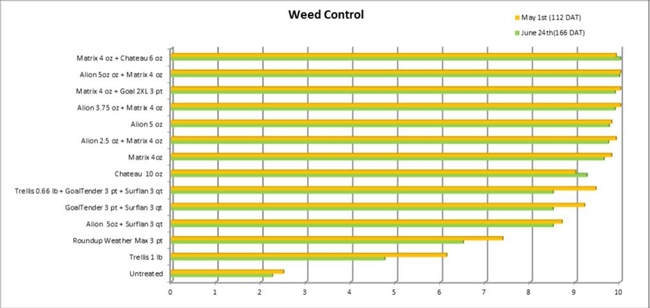Reposted with permission from the January 2014 issue of "CWSS Research Update and News", a semiannual publication by the California Weed Science Society. Check out that issue for several other interesting research and extension articles. Take care, Brad
Control of Willowherb in California's North Coast Vineyards
- John Roncoroni, UCCE Napa County
Biology and Background.


Effect of grape leaf litter on weed control.
Method. I conducted a trial in a mature merlot grape vineyard in Rutherford, Napa County, CA during the winter of 2007. Seven sets of contiguous paired plots were established in one row. Each plot was 4 vines (24 feet) long. Leaves were removed in raked plots by hand, using a standard leaf rake before treating the plots on December 12, 2007. An application of 10 oz./ac Chateau (flumioxazin) plus 24 oz./ac Roundup Pro (glyphosate) and BroncPlus (ammonium sulfate + surfactant mix) was made by two ATV sprayers, one from each side of the row using a single OC04 nozzle. Just prior to application a visual evaluation was made to determine the amount of grape leaf cover (percent) in each of the unraked plots.
Evaluations. (See table 1) Filaree, predominantly whitestem filaree (Erodium moschatum) and some redstem filaree (Erodium cirutarium), was evaluated at 72 DAT. Evaluations were made on a percent cover basis using the average of two 0.5 meter by 1 meter quadrats to determine the effectiveness of the treatment. The subsequent evaluations were made on the entire plot using a visual evaluation of weed control. A visual rating of 1 means that the weed was not controlled; a rating of 10 means complete control of the weed. Weeds evaluated in the ‘weed control' rating at the 93 DAT rating were whitestem and redstem filaree, willowherb, common groundsel (Senecio vulgaris), annual sowthistle (Sonchus oleraceus), spiny sowthistle (Sonchus asper), and prickly lettuce (Lactuca serriola).
Results and discussion. The data in Table 1 show that removing grape leaves before making the herbicide application in this trial had a dramatic effect on the amount of filaree remaining. The greatest difference in control was seen at the highest amount of leaf cover. Willowherb control was affected, even at the 176 DAT rating. There does not appear to be a relationship between the amount of leaf cover and the effect on willowherb control, but all levels in this test resulted in what would not be considered unacceptable control by growers.
The leaves that covered the ground and interfered with weed control will often breakdown or blow away allowing the weeds to continue to grow. A second glyphosate treatment in the late spring or early summer (before verasion) is a standard practice in many vineyards. This will control many weeds but willowherb is very tolerant of glyphosate (Kassim al-Khatib, UCIPM director, personal communication) and will not be controlled. These plants continue to grow but often take on an appearance of being mowed, with much of the growth now being done through the lateral buds. Willowherb like some other weeds leaves a skeleton when the plant senesces in the late fall. This skeleton holds grape leaves that fall from the vine, restricting the wind from blowing them away, perpetuating the cycle of growth.
Willowherb control.
Methods. We initiated a test on January 9, 2013 in American Canyon, Napa County, CA. Several herbicides and combinations were tested for control of vineyard weeds, primarily willowherb. All treatments were applied at 30 GPA with a CO 2 backpack sprayer using a single 8004E nozzle. All treatments (except untreated control, UTC) contained 3 pints/ac Roundup WeatherMax (glyphosate) and ProAMS at 0.25%. All grape leaves were removed from the trial site prior to herbicide applications.
Evaluations. A visual rating of 1 means that the weed was not controlled; a ratingof10 means completecontrol of the weed. Willowherb was the predominant weed present in this study while whitestem filaree and broadleaf filarere (Erodium botrys) were the next most prominent, but in much lower concentrations.
Results and discussion. (see Table 2) This test was conducted under less than desirable conditions. The current California drought began in January 2013. This site received 10 inches of precipitation prior to application, a rain event of 0.23 inches occurred 13 days after application, but only a total of 2.17 inches of rain fell between application and the end of the growing season. This lack of precipitation caused a high degree of variability in the results. Matrix (rimsulfuron), Alion (indaziflam), Chateau (flumioxazin) (all combined with glyphosate) and combinations of these treatments provided very good season long control. Trellis (isoxaben)and Surflan (oryzalin) did not perform as well under these trial conditions for the control of willowherb.
Conclusions. After six years of testing herbicides for the control willowherb several trends became evident. Glyphosate alone is not effective on willowherb, especially those four inches or larger. Rely (glufosinate) has been very effective on willowherb, but it's availability to grape growers has been limited in recent years. The herbicides that have been the most effective on willowherb in several tests are Chateau and Matrix. Under ‘normal' winter conditions both herbicides control willowherb effectively. Other herbicides such as Goal (oxyfluorfen), Prowl (pendimethalin), Surflan and Trellis are effective on many broadleaf weeds but have shown variable, though less than complete control of willowherb in the north coast when used as a single preemergent herbicide when mixed with glyphosate. The realization that many weeds are tolerant, or have developed resistance to glyphosate has demonstrated that the dependence on any one herbicide will lead to decreased weed control.
Reference: Weeds of California and Other Western States, 2007 J.M DiTomaso and E.A. Healy, University of California Press.


